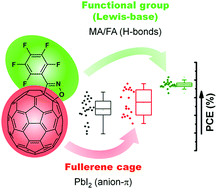Unravelling fullerene–perovskite interactions introduces advanced blend films for performance-improved solar cells†
Abstract
Fullerenes have become one of the most interesting families of molecules to be used in perovskite solar cells. A wide range of derivatives have been designed and applied in these types of devices due to their ability to passivate defects. However, the relevance of these functionalisations in the device performance is not clear yet, as there might be perovskite–fullerene interactions yet to be figured out. In this work a new set of spectroscopic techniques is proposed for the identification of perovskite:fullerene complexes that could be generated in solution, focusing on the non-covalent interactions taking part. The obtained results allow understanding the importance of suitable chemical modification of fullerenes and the implications that the functional group has in the thin film scenario. In this sense, a new fullerene with an optimised structure, FU11, is synthesised and applied in blend films with perovskite, achieving an efficiency of up to 18.3% and universality for different cell configurations. Furthermore, a clear correlation can be observed between the ability of the fullerene to coordinate the perovskite and the final solar cell performance.



 Please wait while we load your content...
Please wait while we load your content...